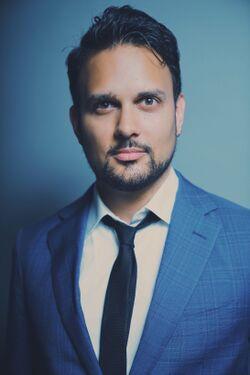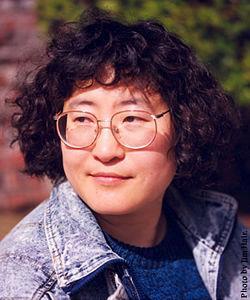
Go Down Moses (2023)
Night Fury (2016)
Salt March (2022)
Dragon Rhyme (2010)
The Crane Wind Ensemble
Brian K. Doyle, conductor
President Suzanne Smith, guest conductor
Voces Terrae: Voices of the Earth
PROGRAM
Consortium Premiere
Carlos SIMON (b. 1986)
Carol BRITTIN CHAMBERS (b. 1970)
Aakash MITTAL (b. 1985)
CHEN Yi
Mysteriously-Harmoniously (b. 1953) Energetically
Intermission
Potsdam Alma Mater (1942)
Symphony No. 4 (1993)
President Suzanne Smith, guest conductor
Charles O’NEILL (1882-1964)
David MASLANKA (1943-2017)
Concert Series 2023-2024 Season
7:30 p.m.
Evening
Helen H. Hosmer Concert Hall Friday, April 19, 2024
Formed in 1956 by Willard Musser, the Crane Wind Ensemble comprises 58 of the most outstanding wind and percussion majors in the Crane School of Music. The CWE performs as a full wind band, and in smaller chamber groups with varied instrumentation. This group is dedicated to the performance of the finest wind repertoire, regardless of period or disposition of instrumental forces. The CWE is also committed to performing music of our time and is active in working with composers in the commissioning of new works to support this goal.
The lineage of principal conductors of the CWE includes Willard I. Musser, Harry I. Phillips, Elliot Del Borgo, Anthony Maiello, TimothyTopolewski,andBrianK.Doyle.Recentguestartistshaveincluded MalloryThompson(virtual),MichaelHaithcock,H. Robert Reynolds, Stacy Garrop, Joe Alessi, John Whitwell, and Frank Battisti.
Since 2006, the CWE has premiered over45 new works forwind band. Recent premieres include works by Erika Svanoe, Nkeiru Okoye, Gregoria Karides Suchy, Shuying Li, James Lee III, Stephen Bryant, Joel Puckett, Kristin Kuster, Roshanne Etezady, David Heinick, James Mobberley, Christopher Theofanidis, Gregory Wanamaker, Dana Wilson, D.J. Sparr, and Andre Previn. The CWE performs at least three performances each fall and spring and also tours regularly. Major off-campus performances have included concerts at the NYSSMA Winter Conference, the NYSBDA Winter Symposium, and at the Division Conference of CBDNA at the Coast Guard Academy (2016) and at Temple University (2020). In November of 2014, the Crane Wind Ensemble released the compact disc, Adirondack Songs
THE
CRANE WIND ENSEMBLE
Piccolo
Julie Williams * ‘24, Music Education & Performance, LaGrange, NY
Flute
Julie Williams * ‘24, Music Education & Performance, LaGrange, NY
Sara McIntyre * ‘24, Music Education, Lockport, NY
Elsie Munsterteiger ‘27, Music Education, Bedford, NH
Emma Scionti ‘25, Music Education, Ronkonkoma, NY
Margo Neth ‘26, Music Business, Verona NY
Renee Rivers ‘26, Music History & Performance, Coeymans Hollow, NY
Simone McPartling ‘26, Music Education & Performance, West Babylon, NY
Oboe
Kayla Outman * ‘25, Music Education, Lagrangeville, NY
Amara Leitner ‘27, Music Education and Performance, Monroe, NY
Mariana Morales ‘27, Music Education & Performance, Hicksville, NY
English Horn
Amara Leitner
Bassoon
Jalen Johnson ‘24, Music Education, Brooklyn, NY
Liam Hill ‘26, Music Education, South Huntington, NY
Contra Bassoon
Jordon Gyarmathy
‘24, MME Music Education, Saratoga Springs, NY
The Crane Wind Ensemble Personnel
E-flat Clarinet
Nicholas Derderian ‘25, Performance, Saratoga Springs NY
B-flat Clarinet
Nick Alvarez * ‘24, Performance, Hopewell Junction NY
Brandon McLauglin
‘26, Music Education & Performance, Cortland, NY
Paige Krebs ‘26, Music Business, Buffalo, NY
Libby Sheldon ‘25, International Studies & Performance, Mexico, NY
Emily Oldfield ‘25, Music Education, Rochester, NY
Jessica Schaller
‘26, Music Education, Bayport, NY
Katie Pullaro ‘26, Music Education, Red Hook, NY
Bass Clarinets
Abby Rodriguez
‘24, Music Education, Saratoga Springs, NY
Jovany Rivers ‘25, Music Education, Brooklyn, NY
Evan Mintz
‘25, Music Education, Commack, NY
Alto Saxophone
Nathaniel Cobb *‡
‘25, Music Education & Performance, Bakersfield, VT
Celeste LaFlamm ‡
‘25, Musical Studies in Composition, Mexico, NY
Alex Brown ’27, Performance, Rome, NY
Tenor Saxophone
Sara Ward
‘27, Music Education & Performance, Churchville, NY
Baritone Saxophone
Carina Phillips
‘25, Music Education, Webster, NY
‡ Soprano Saxophone
Trumpet
Molly Collins *
‘26, Music Education & Performance, Pittsford, NY
Rebecca Wertenberger
‘24, Performance, Hot Springs, AR
Brian McNamara
‘26, Music Education, Amsterdam, NY
Casey Asaro
‘25, Performance & Psychology, Clifton Park, NY
Zoe Fragapane
‘26, Music Education & Performance, Rome, NY
Michael Digman
‘24, Music Education, East Greenbush, NY
Horn
Michael Shipps
‘24, Performance, Lakeland, FL
Heather Murphy
‘24, Music Education & Performance, Poughquag, NY
Ryan Eckl
‘25, Music Education & Performance, Buffalo, NY
Sophia Randazzo
‘25, Music Education & Performance, West Islip, NY
Natalie Hartmann
‘25, Music Education, Farmingville, NY
Dario Longobardi
‘25, Music Business and Performance, Kings Park, NY
Trombone
Andrew Gorman *
‘24, Music Education, Troy, NY
Elliot Borden
‘26, Music Education & Performance, Buffalo, NY
Tobey Dwyer
‘27, Music Education, Rockville Centre, NY
Bass Trombone
Samir Ghalayini
‘25, Performance, Westfield, MA
Euphonium
Jennifer Carden *
‘24, Performance, Buffalo, NY
Aiden Sears
’24, Music Education, Poughkeepsie, NY
Tuba
John Lithco *
‘24, Performance, Poughkeepsie, NY
Henry Stringer
‘24, Mathematics & Performance, Fairport, NY
Zach Barstow
‘26, Music Education and Performance, Camillus NY
Double Bass
Logan Monti
’27, Music Education, Point Lookout, NY‘
Percussion
Bailey Yerdon *
‘26, Music Education & Performance, Altamont, NY
Wyatt Calcote
‘27, Performance, Le Roy, NY
Kameron Balcom
‘26, Music Education, Pulaski, NY
Elisabeth Skalski
‘27, Music Education, Westtown, NY
Hailey Gomez
‘27, Music Education, Marcellus, NY
Nadav Isak
’27, Music Education, Poughkeepsie, NY
Piano
Jack Jiang
‘25, Musical Studies in Music Theory & Performance, Plainview, NY
Organ
Johanna Saint-Vil
’25, Music Education & Piano Pedagogy
Harp
Ricky Chui
‘25, Music Education & Performance, Staten Island, NY
Librarians
Ashley Colucci
Kayla Outman
* Section Principal

GO DOWN MOSES
Carlos Simon
The Jewish biblical story of the plagues of Egypt resonated with the enslaved, and they created songs that related to this story of bondage. While the horrific plagues that swept across Egypt are compelling in and of themselves, the focus of this piece is recounted from the perspective of the stubborn Pharaoh, who unwillingly loosens his grip on the enslaved people. Pharaoh's hardened heart is conveyed through two sharp, accented chords. The spirit of God, represented by light, heavenly, metallic sounds from the percussion, signal the beginning of each new plague. Frogs, pestilence, sickness and are not enough to break the Pharaoh's will. It is only with the "Angel of Death”, which takes the life of Pharaoh's first-born child, represented by dark, brooding harmonies, that he relents in despair. The orchestral texture grows thinner and thinner as Pharaoh loathes in emotional anguish. The once prideful Pharaoh is now broken down to a powerless whimper. I use the Negro Spiritual, Let My People Go (Go Down Moses) as a musical framework throughout this movement.
“Let My People Go” is a phrase that originates in the Book of Exodus 5:1:
And afterward Moses and Aaron went in, and told Pharaoh, Thus saith the LORD God of Israel, Let my people go, that they may hold a feast unto me in the wilderness.
Go Down Moses was commissioned by the conducting students of Michael Haithcock, in celebration of his retirement as director of bands from the University of Michigan.
Program Note by Carlos Simon

NIGHT FURY
Carol Brittin Chambers
Night Fury is intended to portray a mythological time period, full of adventure and excitement with images of dragons, castles, and other legendary creatures. Composer Carol Brittin Chambers was highly influenced by dramatic film scores while creating this epic, fast-paced composition playable by young musicians.
Night Fury was commissioned by the Argyle Middle School Band in Argyle, Texas.
Program Note by Carol Brittin Chambers
PROGRAM NOTES
• 20 March 2024
CWE

Aakash Mittal
While the heart and soul of Salt March for Wind Ensemble is a tribute to Mohandas K. Gandhi's historical protest and the music of that moment, fragments ofthe marchingmusic prevalentduring my childhood are woven into this composition. When I was eleven years old and still living in Dallas, Texas, I joined a Civil War-era fife and drum band. Around the same time that I was playing the Battle Hymn of the Republic on fife, I also began playing clarinet in my school's wind band. This marked the beginning of a decade-long experience playing marches by Sousa, Grainger, and Berlioz. Cemented by four years of competitive high school marching band, marching in local parades, and playing marches at the town's veterans club, the march became ingrained in my musical DNA.
The march became part of my life again during the 2020 pandemic. Black Lives Matter and the Women's March put a spotlight to the power of the march as an effective type of non-violent protest that is still in use today. As the pandemic raged on, the idea of expressing our current climate of activism by writing a piece about Gandhi's Salt March came to mind again and again. I wanted the piece to be an opportunity to study an important point in history and remind students that they already have the power to make positive change in the world. My intent for Salt March was to remind us of where we have been and relate that history to the activism taking place right now. Salt March for Wind Ensemble is a contemporary imagining of the 1930 protest rather than a historically accurate rendering. However, I wanted to arrange a song that was sung during the original march to nestle a seed of that history in this piece. As many others have, I assumed that Gandhi and his followers sang during the historic journey. Photographs taken of the event clearly included musicians holding instruments. However, I struggled to find written references to any of the songs or music of that moment. It was at this point in my research that my cousin Gourav Venkateswar pointed me toward the devotional song Ragupati Raghava Raja Ram. Now the floodgates had been opened! I found reference upon reference corroborating that, indeed, Gandhi and his collaborators sang this song during the Salt March.
As I read about Gandhi's work, I discovered he was quite a proponent of music. Politically, he believed that "in true music there is no place for communal differences and hostility." This was further highlighted in a letter Gandhi wrote to the music teacher in the Satyagraha Ashram, Sabarmati, stating that "I have gradually come to look upon music as a means of spiritual development ... Music is a constructive activity, which uplifts the soul." Gandhi's regard for music as a vehicle for spiritual development and political activism resonates with me and informed the writing of Salt March. The piece is as much an expression of the inner journey one must undertake to transform oppressive systems as it is about the power of communal protest. It is also about the idea that joy, celebration, and healing are revolutionary forces in and of themselves. Therefore, this piece Is quite simply a catchy melody over some grooving drumbeats. I hope you enjoy the music.
Program Note by
Aakash Mittal

DRAGON RHYME
Chen Yi
Dragon Rhyme for symphonic band has two movements: I. Mysteriously-Harmoniously, and II. Energetically. The first movement is more lyrical and the second powerful. You will hear that the thematic material found in each movement is related and consists of the basic intervals found in Beijing opera music. The instrumental textures within this piece range from transparent and delicate, to angular and strong. This variety is meant to spark the image of a dragon, which is auspicious, fresh, and vivid, and results in music that is layered and multidimensional similar to the Eastern culture.
The work was Commissioned by the National Wind Ensemble Consortium Group and premiered by the Hartt Wind Ensemble at Carnegie Hall under the baton of Dr. Glen Adsit on May 30, 2010
Program Note by Chen
Yi
SALT MARCH
Charles O’Neill – music
Marie Schuette & William Trauger – text
On the banks of Raquette River, With its hills of blue, Stands our honored Potsdam College, Stirring sights to view Hail, Potsdam College!
In reverence we acknowledge, Strength from thee, from thee Oh, Alma Mater Praise, all praise Potsdam.

Dr. Suzanne Smith is SUNY Potsdam's 18th president and joined the campus in April 2023. She was appointed to the position by the SUNY Board of Trustees at the recommendation of Chancellor Dr. John B. King, following a nationwide search.
Dr. Smith comes to SUNY Potsdam from Georgia Southwestern State University in Americus, Ga., where she had served as provost and vice president for academic affairs since 2018. In this position, she was responsible for the academic programming and planning for the university, and the allocation of resources to meet programmatic priorities. During her time at GSW, Smith led an academicplanning processwhich resulted inthe establishment ofseveral newdegreeprograms designed to meet student and regional workforce needs. She helped raise more than $2 million dollars for one of those programs by working with community partners and seeking external grants. She also led the campus post-pandemic strategic task force, which resulted in the development of GSW’s three pillars of excellence: People, Purpose, and Profession. Prior to GSW, Dr. Smith served at Washington State University Vancouver from 1997 to 2018, ultimately being named the director of academic planning and special assistant to the vice chancellor of academic affairs. During her time at Washington State Vancouver, she transitioned from faculty to administration by serving 10 years as an academic director.
As a professor, Dr. Smith has more than 25 years of experience teaching sociology and human development at the university level. She has received multiple awards for excellence in teaching and has written numerous journal articles and books, including her latest co-authored textbook “Exploring Family Theories” (5th Ed), published in 2021. Dr. Smith is an active member of the National Council of Family Relations and the Family Science Association.
Dr. Smith received her Ph.D. in child and family development from the University of Georgia, her Master of Science degree in family and child development from Virginia Polytechnic Institute and State University, and her Bachelor of Arts degree in behavior science from Erskine College. She has completed the Harvard Graduate School of Education Management Development Program and the American Association of State Colleges and Universities Millennium Leadership Institute.

SYMPHONY NO. 4
David Maslanka
The sources that give rise to a piece of music are many and deep. It is possible to describe the technical aspects of a work its construction principles, its orchestration but nearly impossible to write of its soul-nature except through hints and suggestions.
The roots of Symphony No. 4 are many. The central driving force is the spontaneous rise of the impulse to shout for the joy of life. I feel it is the powerful voice of the Earth that comes to me from my adopted western Montana, and the high plains and mountains of central Idaho. My personal experience of the voice is one of being helpless and torn open by the power of the thing that wants to be expressed the welling-up shout that cannot be denied. I am set aquiver and am forced to shout and sing. The response in the voice of the Earth is the answering shout of thanksgiving, and the shout of praise.
Out of this, the hymn tune Old Hundred, several other hymn tunes (the Bach chorales Only Trust in God to Guide You and Christ Who Makes Us Holy), and original melodies which are hymn-like in nature, form the backbone of Symphony No. 4
To explain the presence of these hymns, at least in part, and to hint at the life of the Symphony, I must say something about my long-time fascination with Abraham Lincoln. Carl Sandburg's
THE P
OTSDAM ALMA MATER
monumental Abraham Lincoln offers a picture of Lincoln indeath. Lincoln's close friend, David Locke, saw him in his coffin. According to Locke, his face had an expression of absolute content, of relief at having thrown off an unimaginable burden. The same expression had crossed Lincoln's face only a few times in life; when after a great calamity, he had come to a great victory. Sandburg goes on to describe a scene from Lincoln's journey to final rest at Springfield, Illinois. On April 28, 1865, the coffin lay on a mound of green moss and white flowers in the rotunda of the capitol building in Columbus, Ohio. Thousands of people passed by each hour to view the body. At four in the afternoon, in the red-gold of a prairie sunset, accompanied by the boom of minute guns and a brass band playing Old Hundred, the coffin was removed to the waiting funeral train.
For me, Lincoln's life and death are as critical today as they were more than a century ago. He remains a model for his age. Lincoln maintained in his person the tremendous struggle of opposites raging in the country in his time. He was inwardly open to the boiling chaos, out of which he forged the framework of a new unifying idea. It wore him down and killed him, as it wore and killed the hundreds of thousands of soldiers in the Civil War, as it has continued to wear and kill by the millions up to the present day. Confirmed in the world by Lincoln, for the unshakable idea of the unity of all the human race, and by extension the unity of all life, and by further extension, the unity of all life with all matter, with all energy and with the silent and seemingly empty and unfathomable mystery of our origins.
Out of chaos and the fierce joining of opposite comes new life and hope. From this impulse I used Old Hundred, known as the Doxology a hymn to God; Praise God from Whom all Blessings Flow; Gloria in excelsis Deo the mid-sixteenth century setting of Psalm 100. I have used Christian symbols because they are my cultural heritage, but I have tried to move through them to a depth of universal humanness, to an awareness that is not defined by religious label. My impulse through this music is to speak to the fundamental human issues of transformation and re-birth in this chaotic time.
Program Note by
David Maslanka







